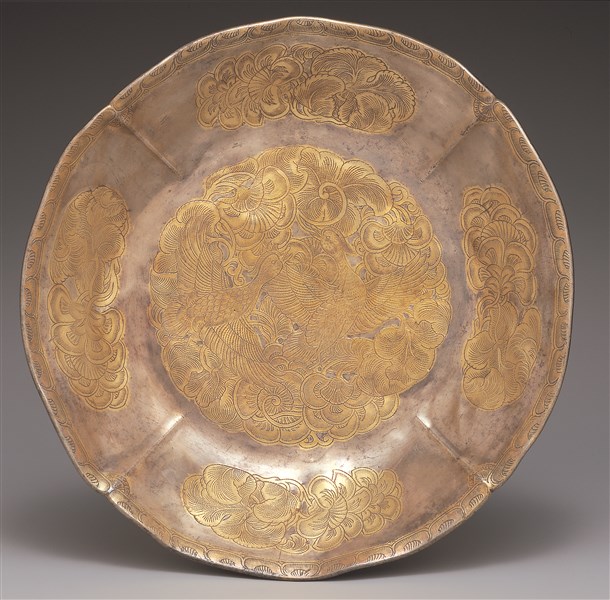鴛鴦文四弁碗
- 中国
- 中国・唐時代
- 8世紀後期-9世紀中期
- 銀鍍金
- H-5 D-22
この碗においては秀明コレクションの他の銀製鍍金の作品にみられるような魚々子地の背景は用いられず,作者は鏨彫による文様を内外面に施す前に表面を磨いて滑らかに仕上げている。手本として型紙を用いたり文様を厳密に表すのではなく,工匠はモティーフをフリーハンドで線刻するという方法をとっている。中央のメダイヨンと隣接する植物モティーフは一つ一つ打ち込みを重ねて線刻され,それは切れ目のない線の形とは異なった,縫い目に似た効果を生んでいる。鉢の外側の葉にもそれぞれ同様に楕円形の花のメダイヨンが彫られている。結局,内外面のモティーフはすべて鍍金が施され,底部は圏足の内側に中国で吉祥をあらわす「吉」の字が書かれている。
Catalogue Entry
Sumptuous silk fabric was China's most famous export product, but in time, other countries discovered how to weave it as well. Indeed, historical records indicate that silk brocade weaving was already established in Persia by the fourth century, and in the sixth century the Persian silk industry was developed to such an extent that rather than acting as a transit point for raw silk, the country began to export locally manufactured material.1 In fact, it is recorded that gifts of Persian fabric were presented to the Chinese court during the reign of the Tang emperor Xuanzong (712-756).2 A major stop for Silk Road travelers was the city of Turfan in the northwest province of Xinjiang, and a site located just outside of this city has yielded a late-eighth-century textile with a distinctive Near Eastern pattern strikingly similar in motif and composition to the designs on this four-lobed bowl.3
Both our bowl and Xinjiang textile contain a central, circular medallion consisting of a cluster of flowers and leaves. Placed equidistantly around the central floral medallion are four smaller, oval clusters of flowers and leaves, chased onto the bowl and woven into the fabric. Rather than featuring two ducks within the central medallion as does the bowl, the textile has four swallows that carry auspicious plants in their beaks, which are positioned equal distances from one another encircling the central medallion.4 Moreover, the Chinese metalworker transformed the more static Near Eastern textile pattern into a distinctively curvilinear floral design reflecting Chinese tastes.
Whether the bowl was fluted into four sections to accommodate the design or the decorative composition was selected to accommodate the four-lobed bowl is unclear. To create this bowl, a round piece of silver was hammered into a shallow wooden form or into a leather bag containing sand, which allowed its form to take shape.5 Next, four lobe lines were hammered from the exterior of the bowl. Finally, the circular foot ring was formed and soldered onto the bowl base.
Rather than employing a ring-matted background like that found on other Shumei silver-gilt pieces, this bowl's maker burnished the surface to a smooth finish before chasing decorations onto its interior and exterior. The artisan elected to chase the motifs free hand rather than use a stencil or exact pattern as a guide. The central medallion and adjacent floral motifs were chased with single, individual taps, creating a stitch-like effect, not a continuous line. But the continuous chased-line technique was used for the bowl's rim decoration, which features overlapping petal patterns. Each exterior lobe of the bowl was chased with an oval floral medallion as well. Finally, all exterior and interior motifs were gilded and the base was inscribed inside the foot ring with an auspicious character, ji.6
Similar types of bowls have been located in Shaanxi province, but excavated examples are few. A four-lobed bowl similar to the Shumei example decorated with two birds in the central medallion was unearthed at the site of Northeastern Industrial University.7 A plate, without a foot but similar in shape and design to the Shumei bowl, was excavated from Lantian and features a pair of birds in each of four oval medallions flanking a central medallion that has no birds.8 Another Lantian plate is circular, rather than lobed in shape; yet it has four floral medallions surrounding a central medallion.9
JMS
1. Perikhanian 1983, p. 741; Shepard 1983, pp. 1107-8; Segraves 1996a, pp. 55-57.
2. Segraves 1996a, pp. 57-58.
3. The textile was unearthed at and is dated 778: see Xinjiang bowuguan 1973, pl. 44.
4. On swallows carrying auspicious floral sprays see cat. no. 132.
5. Technical information courtesy of Richard H. Kimball.
6. Metropolitan Museum 1996, p. 149.
7. Zhenjiang bowuguan Shaanxi sheng bowuguan 1985, pl. 141, fig. 142.
8. Kaogu yu Wenwu 1982.1, p. 47, fig. 2.
9. Ibid., p. 47, fig. 4.
